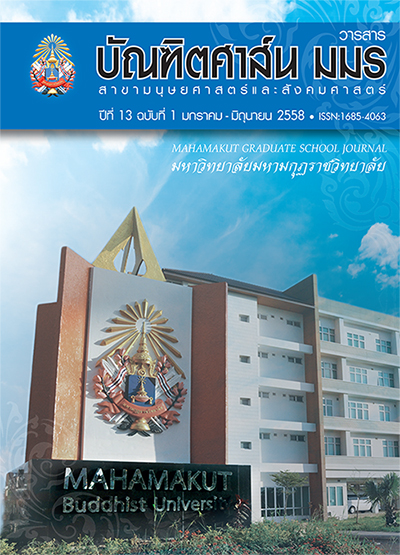ศึกษาลักขณูปนิชฌานในการเจริญวิปัสสนาภาวนา ในคัมภีร์พุทธศาสนาเถรวาท
บทคัดย่อ
วิทยานิพนธ์ฉบับนี้มีวัตถุประสงค์ 3 ประการ คือ 1. เพื่อศึกษาสภาวฌานในคัมภีร์พุทธศาสนาเถรวาท 2. เพื่อศึกษาลักขณูปนิชฌานในคัมภีร์พุทธศาสนา เถรวาท 3. เพื่อศึกษาการเจริญวิปัสสนาภาวนาเพื่อ ให้เกิดลักขณูปนิชฌาน โดยการศึกษาข้อมูลจากคัมภีร์ พุทธศาสนาเถรวาทว คือ พระไตรปิฎก อรรถกถา ฎีกา และคัมภีร์อื่นๆ ที่เกี่ยวข้อง เช่น คัมภีร์วิสุทธิ มรรค เป็นต้น โดยการรวบรวมข้อมูลนำมาประมวล วิเคราะห์โดยเรียบเรียงบรรยายเชิงพรรณนา และ สรุปตรวจสอบความถูกตอ้ งโดยผูเ้ ชี่ยวชาญ
ผลการวิจัยพบว่า
สภาวฌาน หมายถึงสภาวจิตที่เพ่งพินิจจนเป็น สมาธิแนว่ แนถึ่งขั้นอัปปนาสมาธิ ซึ่งมีอยู่ 2 แบบ คือ (1) การเพ่งอารมณ์บัญญัติ คือ รูปฌาน และอรูป ฌาน เป็นสมถภาวนา ให้ผลสูงสุด คือ สมาบัติ 8 และอภิญญา 5 เรียกว่า อารัมมณูปนิชฌาน (2) การ เพ่งอารมณ์ปรมัตถ์ คือการเพ่งลักษณะของสังขารให้ เห็นความเป็นไตรลักษณ์ เป็นวิปัสสนาภาวนา ให้ผล สูงสุดคือ มรรค ผล นิพพาน เรียกว่า ลักขณูปนิชฌาน
ลักขณูปนิชฌาน หมายถึงการเพ่งลักษณะ ซึ่งเป็นปรมัตถ์อารมณ์ ได้แก่ วิปัสสนา มรรค ผล วิปัสสนาชื่อว่า ลักขณูปนิชฌาน เพราะเพ่งพินิจ สังขารโดยไตรลักษณ์ มรรคชื่อว่า ลักขณูปนิชฌาน เพราะยังกิจแห่งวิปัสสนาให้สำเร็จ ผลชื่อว่า ลักขณู ปนิชฌาน เพราะเพ่งพินิจอันมีลักษณะสุญญตะ อนิมิตตะและอัปปณีหิตะอย่างหนึ่ง และเพราะเห็น ลักษณะสัจจภาวะนิพพานอย่างหนึ่ง
การเจริญวิปัสสนาภาวนาเป็นหนทางการทำให้ เกิด ลักขณูปนิชฌาน ซึ่งมีวิธีหลักใหญ่ อยู่ 2 วิธีคือ (1) สมถปุพพังคมวิปัสสนาเป็นการเจริญวิปัสสนา โดยใช้ฌานเป็นบาทฐาน ผู้ที่ปฏิบัติแนวนี้เรียกว่า สมถยานิก (2) วิปัสสนาปุพพังคมสมถะเป็นการเจริญ วิปัสสนา โดยไม่มีฌานเป็นบาทฐาน แต่ใช้ขณิกสมาธิ จนเกิดกำลังเทียบเท่า ฌาน ผู้ปฏิบัติแนวนี้เรียกว่า วิปัสสนายานิก ซึ่งทั้ง 2 วิธีนี้ เป็นการเจริญวิปัสสนา ตามหลักสติปัฏฐานสูตร อันเป็นทางสายเดียวที่ สามารถพ้นจากอำนาจครอบงำของกิเลสที่สุดคือนำ ไปสู่ความหลุดพ้นที่ยั่งยืนอย่างแท้จริง
เอกสารอ้างอิง
มหาจุฬาลงกรณราชวิทยาลัย. พระไตรปิฎกภาษาไทย เล่ม 1, 10, 11, 12, 13, 14, 25, 31, และ 34. กรุงเทพมหานคร : โรงพิมพ์มหาจุฬาลงกรณราชวิทยาลัย, 2539.
มหามกุฏราชวิทยาลัย. พระไตรปิฎกอรรถกถา ภาษาไทย. กรุงเทพมหานคร: โรงพิมพ์มหามกุฏราช วิทยาลัย, 2534.
พระพุทธโฆสเถระ. คัมภีร์วิสุทธิมรรค. แปลโดย สมเด็จพระพุฒาจารย์ (อาจ อาสภมหาเถร), พิมพ์ครั้ง ที่ 5. กรุงเทพมหานคร: บริษัท ธนาเพรส จํากัด, 2554.
พระอนุรุทธะ และ พระญาณธชะ. อภิธัมมัตถสังคหะ และ ปรมัตถทีปนี. แปลโดย พระคันธสาราภิ วงศ์. พิมพ์ครั้งที่ 1. กรุงเทพมหานคร: หจก.ไทยรายวันกราฟฟิคเพลท, 2546.
ข้อมูลทุติยภูมิ
(1) หนังสือทั่วไป
พระโสภณมหาเถระ. วิปัสสนานัย เล่ม 1. แปลโดย พระคันธสาราภิวงศ์. กรุงเทพมหานคร : หจก. ประยูร สาส์นไทย การพิมพ์, 2548.
พระบัณฑิตาภิวงศ์ กัมมัฏฐานาจริยะ. รู้แจ้งในชาตินี้ (In This Very Life), แปลโดย พระคันธสาราภิ วงศ์. พิมพ์ครั้งที่ 7. กรุงเทพมหานคร: โรงพิมพ์ บริษัท สหธรรมิก จํากัด, 2550.
พระพรหมคุณาภรณ์ (ป.อ. ปยุตโต). พจนานุกรมพุทธศาสตร์ ฉบับประมวลธรรม (Dictionary of Buddhism). พิมพ์ครั้งที่ 21. กรุงเทพมหานคร: บริษัท สหธรรมิก จํากัด, 2554.
ผ.ศ.(พิเศษ) สมบูรณ์ ตาสนธิ. อันตรธานธรรม. กรุงเทพมหานคร: สํานักพิมพ์ ธิงค์บียอนด์ธรรมะ, 2554.
(2) วิทยานิพนธ์
พระคณินโสทโร (เมืองเกิด). “ศึกษาการพัฒนาปัญญาเพื่อการบรรลุธรรมในพระพุทธศาสนาเถรวาท”. วิทยานิพนธ์พุทธศาสตร์มหาบัณฑิต. บัณฑิตวิทยาลัย : มหาวิทยาลัยมหาจุฬาลงกรณราชวิทยาลัย, 2556.
พระปัญญา ธนปญโญ (บัวทอง).“ศึกษาเชิงวิเคราะห์เรื่องสมถกัมมัฏฐานในพระพุทธศาสนาเถรวาท” วิทยานิพนธ์พุทธศาสตร์มหาบัณฑิต. บัณฑิตวิทยาลัย: มหาวิทยาลัยมหามกุฏราชวิทยาลัย, 2542.
พระมหากฤช ญาณวุโธ (ใจปลื้มบุญ). “การศึกษาวิเคราะห์ความสัมพันธ์ระหว่างฌานและปัญญาใน พระพุทธศาสนาเถรวาท”.วิทยานิพนธ์พุทธศาสตรมหาบัณฑิต. บัณฑิตวิทยาลัย : มหาวิทยาลัยมหาจุฬา ลงกรณราชวิทยาลัย, 2547.
พระมหาศักดิ์ศรี ปุญฺญธโร (เชื้อชํานาญ). “ศึกษาความสัมพันธ์ระหว่างฌานกับญาณในคัมภีร์พุทธ ศาสนาเถรวาท”. วิทยานิพนธ์พุทธศาสตร์มหาบัณฑิต. บัณฑิตวิทยาลัย : มหาวิทยาลัยมหาจุฬาลงกรณ ราชวิทยาลัย, 2556.
ดาวน์โหลด
เผยแพร่แล้ว
รูปแบบการอ้างอิง
ฉบับ
ประเภทบทความ
สัญญาอนุญาต
บทความวิชาการและบทความวิจัยในวารสารฉบับนี้ถือเป็นความรับผิดชอบของผู้เขียนเท่านั้น บทความที่ได้รับการตีพิมพ์ในวารสารบัณฑิตศาส์น ถือเป็นลิขสิทธิ์ของมหาวิทยาลัยมหามกุฏราชวิทยาลัย ตามพระราชบัญญัติลิขสิทธิ์



